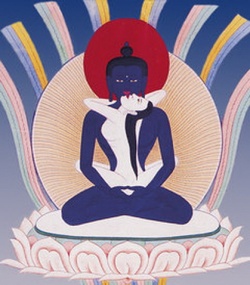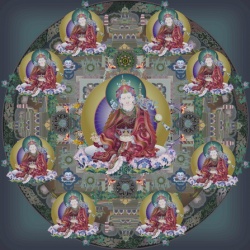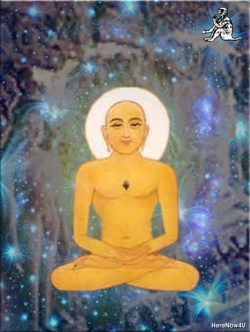Kalacakra Laghutantra
Kalachakra Laghutantra Kālachakra (Sanskrit: कालचक्र, IAST: Kālacakra; Telugu: కాలచక్ర Kannada: ಕಾಲಚಕ್ರ; Tibetan: དུས་ཀྱི་འཁོར་ལོ།, Wylie: dus-kyi 'khor-lo; Mongolian: Цогт Цагийн Хүрдэн Tsogt Tsagiin Hurden; Chinese: 時輪) is a Sanskrit term used in Tantric Buddhism that literally means "time-wheel" or "time-cycles". The spelling Kālacakra is also used. The word Kālachakra is usually used to refer to a very complex teaching and practice in Tibetan Buddhism. Although the teaching is very advanced, esoteric, and difficult to comprehend, there is a tradition of offering it to large public audiences.
"The Kalachakra Tantra is more properly called the Kalachakra Laghutantra, and is said to be an abridged form of an original text, the Kalachakra Mulatantra which is no longer extant.
Having learnt the 12,000 verses Kalachakra Multantra, King Suchandra returned to Shambala and wrote a 60,000 verse on the Multantra. Seven generations later, Manjushrikirti established Kalachakra as the main religion of Shambala and wrote a 1,000 verse summary of the Mulatantra called the Kalachakra Laghutantra. His successor Pundarika wrote a 12,000 verse commentary on the Laghutantra titled Vimalaprabha. During the time of the twelfth propagator, the Kalachakra teachings were brought into India by two Indian pundits, and in the eleventh century, these teachings were taken into Tibet by Tsong-Kha-pa.
The Kalacakra Tantra is more properly called the Kalacakra Laghutantra, as it is an abridged form of the original text - the Kalacakra Mulatantra. It is said by the Tibetan historian Taranatha, that the Mulatantra was taught by the Buddha on the full moon of the mounth Caitra in the year following his enlightenment, at the great stupa of Dhanyakataka in India. This teaching had been requested by the king Sucandra from Sambhala (often written "Shambhala").
Sucandra returned to Sambhala and wrote the Tantras in textual form there. He composed the explanatory Tantra in 60,000 lines as a commentary on the original Mulatantra of 12,000. A later king of Sambhala, Yashas, wrote the abridged form of the Tantra, the Kalacakra Laghutantra. This is about one quarter of the length of the original Mulatantra. This text survives today, and is generally known simply as the Kalacakra Tantra
The Abridged Kalachakra Tantra and its main commentary, Stainless Light, are probably combinations of portions written in different places at different times. It is difficult to date their compilation in Sanskrit.
In the Buddhist view...the Buddha taught The Root Kalachakra Tantra in the ninth century BCE and that the First Kalki King of Shambhala compiled The Abridged Kalachakra Tantra seven centuries later. Only the latter text has survived....The Abridged Kalachakra Tantra was composed between the end of the ninth and the beginning of the tenth centuries CE, as a composite of different portions compiled in perhaps several areas in the region spanning eastern Afghanistan (Balkh, Sham i bala, Oddiyana, and Kashmir). It reflects the world situation in which Buddhists of that period in those regions lived.
966 AD...Kalachakra becomes widely known in India
The Kalachakra Tantra reached Tibet from Kashmir in 1027, the year predicted by the First Kalki....the first sixty-year Kalachakra cycle began in 1027 CE. The Tibetan astrological tradition considers this the year that the Kalachakra teachings were introduced to Tibet....
Kalachakra teachings were available by 1027 in Kashmir. At the end of the tenth and beginning of the eleventh centuries CE, Kashmir was a center for both Buddhist and Hindu Shaivite tantra. Evidence that the Kalachakra teachings were present there at this time comes from the appearance of a Hindu critique of the Buddhist Kalachakra meditation system in the sixteenth chapter of the Kashmiri Shaivite tantra text Illuminating the Tantras (Skt. Tantraloka), written by the Kashmiri pandit Abhinavagupta. According to some scholars, Abhinavagupta wrote his text between 990 and 1014 CE and died in 1025....During the latter part of the tenth and the beginning of the eleventh centuries CE, communication was quite common between the Buddhists of Oddiyana (Bactria) and Kashmir.
The Turkic Ghaznavids conquered Kabul in the 980s. It was at about this time that the Kalachakra teachings openly appeared in India, transmitted in visions to two Indian masters attempting to reach Shambhala. Although the Muslim Ghaznavids tolerated Buddhism and Hinduism in Kabul, they looted and destroyed the wealthy Buddhist monasteries that lay in their path to the East.
The Stainless Light (Tib. Dri-med ‘od, Skt. Vimalaprabha) commentary to The Abridged Kalachakra Tantra. ....According to tradition, both texts were compiled in Shambhala, the tantra by the FirstKalki (Tib. Rigs-ldan) ruler Manjushri-yashas (Tib. ‘Jam-dpal grags-pa) and the commentary by his son, the Second Kalki ruler Pundarika (Tib. Padma dkar-po).
A passage in The Abridged Kalachakra Tantra that mentions “those that wear red and those that wear white,” Stainless Light explains that “Buddhists wear red and the non-Indic invaders wear white.
Caliph al-Mahdi (ruled 775-785 CE)... invited Buddhist scholars from India and from the huge Nava Vihara monastery in Balkh, Afghanistan to Baghdad to work at the newly constructed House of Knowledge to translate texts into Arabic – further evidence of his lack of intolerance of Buddhism. They worked there from the late eighth to the early ninth centuries CE.....
The most prevalent form of Christianity in the Abbasid Empire, from Syria to Balkh, was the Nestorian branch of the Syrian Orthodox Church, started in the early fifth century CE by Nestorius, Patriarch of Constantinople. It taught that Jesus was born with a human nature and that his divine nature entered him afterwards. The Council of Chalcedon declared it a heresy in 431 CE. It was the form of Christianity with which Muhammad was acquainted.
Buddhist tantra does not seem to have been practiced in eastern Afghanistan but elements of the Kalachakra teachings were found there. The twelve astrological signs of the zodiac were painted around the walls of the main halls of the Buddhist monasteries in Kabul. This motif was found both in Iranian royal palaces and in the Kalachakra mandala, where deities representing the twelve signs surround the palace. Mahmud of Ghazni did not destroy these monasteries.
The Shambhala ruler Manjushri Yashas (The first Kalki King of Shambhala) warned the Hindu sages about their descendents adopting the invaders’ Dharma....According to the Kalachakra texts, the prediction of the non-Indic invasion was given by Manjushri Yashas in the second century BCE. The prediction was that the invasion would be launched in 2424 CE.
The Vishnu Purana.... In the Kalachakra version of the messiah prediction, universes periodically go through cycles of four ages, following the laws of astronomy and astrology. Seven centuries before the end of the current fourth age (the kaliyuga), the king of Shambhala will unify all his Hindu and Buddhist subjects into one caste to face the future invasion that will end the age. The unifying king will be Manjushri-yashas, who will take the title Kalki and be the first of a line of twenty-five Kalki rulers of Shambhala.
Uniting in the Kalachakra mandala is not equivalent to joining a monasic institution and becoming a Buddhist. It was not the First Kalki’s intention that everyone must convert to Buddhism. The aim was for them to live together in harmony and peace, like one caste.


